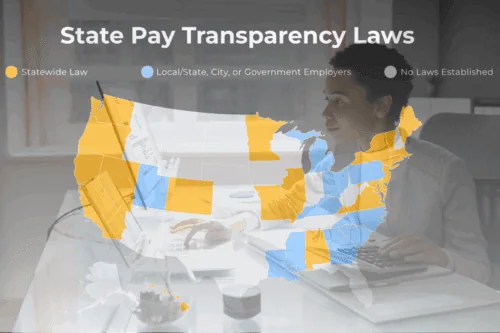Pay is Up & So Are Your Bills
The Q2 2025 Employment-Cost Index just dropped. Wages climbed 3.6% year-over-year, according to the Bureau of Labor Statistics. That’s solid… Until you compare it to your grocery receipt.
Even in a cooling economy, employers are still shelling out to win (and keep) skilled workers. The Robert Half 2025 Salary Guide spotlights the hardest-to-fill roles, from cybersecurity analysts to construction estimators, many seeing double-digit bumps in compensation.
So how do you get in on this? This guide breaks down:
- Where the biggest raises are happening
- Which roles are red-hot (and “recession-proof”)
- How to actually ask for more money… and get it
Let’s talk about the raise you should be getting.
Wage Gains Are (Technically) Beating Inflation
So why does it still feel so tight?
Here’s the Math
Core inflation, as measured by the Fed’s preferred PCE index, sits at 2.8%. Median wages though? Climbing somewhere between 3-4%, depending on your industry.
So yes, in the raw numbers, Americans are seeing actual wage growth for the first time in years. But, if your raise was 3.6% and your rent jumped up 8%… you’re still losing ground.
The 2025 Paradox: Wages are rising faster than inflation, but not faster than your actual life costs.
And There’s a Twist
It’s the lowest-paid workers who are logging the biggest percentage gains. Jobs like food service managers, warehouse supervisors, and CNAs are catching up after years of inactivity. According to Indeed Hiring Lab, wage growth at the bottom of the pay scale has outpaced the top for much of the past year.
This compression is a double-edged sword. On one hand, it narrows those historic pay gaps. Yet on the other, it flattens raise potential for mid- and senior-level professionals, especially in jobs where AI is starting to automate away the “nice-to-have” skill sets.
5 Sectors With the Biggest Raises
According to recent data, these five sectors are leading the pack when it comes to salary growth:
1. Renewable Energy & Electric Vehicles
Wind turbine technicians, battery engineers, and grid modernization experts are seeing raises well above the national average. Many of these jobs now pay $90K+ with minimal formal schooling, and the demand is outpacing supply in nearly every state.
This “Green-Collar” boom isn’t just for engineers and scientists. It’s sweeping up electricians, mechanics, as well as project and site managers too.
2. Cybersecurity & AI Governance
With deepfake scams and LLM leaks making headlines, cybersecurity jobs are now mission-critical. Salaries for senior analysts and risk officers are jumping 10-15% YoY, especially in finance and government. AI governance jobs, which are still nascent, are being built from scratch and come with big pay to match their ambiguity.
3. Healthcare Tech & Telehealth
Behavioral health NPs, virtual care coordinators, and health data analysts are seeing strong growth, especially in states with provider shortages. The hybridization of healthcare (in-person + digital) is driving the surge of new job titles and new pay bands.
4. Skilled Trades (Infrastructure Boom)
Thanks to bipartisan infrastructure funding, roles like construction estimators, heavy equipment operators, and HVAC technicians are getting big raises, plus bonuses. Demand is especially high in transit, broadband, and clean water projects.
5. Logistics & E-Commerce Automation
Warehouse technicians, robotics maintenance workers, and supply chain analysts are riding the second wave of post-COVID ecommerce growth. Jobs supporting automated fulfillment centers are now commanding premium hourly wages + benefits packages, especially in the South and Midwest.
So, if you’re looking for a career move that pays off fast, just follow the money… And right now, that money trail leads to renewables, AI, healthcare tech, skilled trades, and even logistics.
Where You Work Still Matters
Location-based pay used to be pretty simple: Big cities meant bigger salaries. But now, the map has sort of redrawn itself, and the hottest wage growth is happening in places most people used to move away from.
The Sun Belt is Booming
Cities like Austin, TX, Phoenix, AZ, and Tampa, FL are leading the way, with compound annual wage growth topping 5%. They are combining high-growth industries, like clean energy, tech, and healthcare with a lower cost of living. That combo lets employers stretch salaries a little farther without breaking the bank.
In a nutshell… You simply don’t have to live in a big city like San Francisco to make six figures anymore.
Remote Roles = Premium Pay… Only With the Right Skills
Despite the scare-tactic headlines about companies calling all their workers back to the office, remote hiring hasn’t vanished. It has however, become much more selective. For in-demand skills like AI for IT Operations, cloud security, or product UI/UX, remote jobs are still earning a 7-10% premium over on-site equivalents.
Good companies know that niche tech workers can, and do, live anywhere. And if they want the best talent, they still have to pay for it.
Pay Transparency Laws
These laws are totally reshaping salaries nationwide. State laws in New York, Colorado, and California now require employers to list pay ranges in job postings. And it’s not just helping locals… Even applicants from out-of-state are using these posted ranges to base their salary requirements, driving up offers across the board.
Pro tip: Bring a screenshot of a public range to your next negotiation. Even if you’re in a state without transparency rules, it works.
5 Jobs Blowing Up, and Paying Up Too
Wage trends are one thing. But if you’re job hunting right now, you probably want specifics. These five jobs are posting the fastest year-over-year growth across multiple salary reports, including LinkedIn’s Jobs on the Rise and the Robert Half 2025 Salary Guide.
1. AI Prompt Engineer
Not just for coders anymore, this job is perfect for people who think fast, write well, and know how to ask the right questions.
Salaries for experienced prompt engineers now hover around $130K-$180K, especially in product, marketing, and enterprise AI teams.
2. Renewable-Energy Technician
This “green-collar” job is climbing big time in both red and blue states. With wind and solar installations accelerating, skilled technicians can earn $80K+ with just a certification, and job security is sky-high through at least 2030.
3. Cybersecurity Analyst
AI may be writing phishing emails now, but it’s also creating new vulnerabilities. That’s why mid-level cyber security professionals are seeing double-digit raises, especially in finance, health, and infrastructure.
Bonus: There are a ton of these roles that are remote-friendly, even for new hires.
4. Behavioral Health Nurse Practitioner (NP)
The shortage is real. Demand for NPs in behavioral and psychiatric care is exploding, particularly in rural and underserved areas. Median compensation is climbing well past $120K, and many of the jobs come with sign-on bonuses, loan forgiveness, and flexible schedules.
5. Construction Estimator
Infrastructure money is flowing, and someone has to run all the numbers. Estimators are in high demand across transportation, energy, and commercial real estate, and salaries have jumped by 15-20% in just 18 months.
TL;DR: These jobs aren’t only trending, they’re also ranking as some of the best companies for diversity and inclusion. They’re available now, recession-resilient and negotiation-ready.
Getting What You’re Actually Worth
In this job market, negotiating is a survival skill. And with emerging pay transparency laws, real-time salary data, and inflation all in the mix, candidates finally have some leverage (if they know how to use it). Here’s how to play it:
Anchor High… But Logically
When you’re given a salary range, don’t just split the difference. Use the midpoint plus inflation as your baseline.
Example: “Given the median BLS data and Robert Half’s 75th percentile benchmark, I’d be looking at something closer to $92K, especially given current inflation rates.”
Cite Public Pay Ranges (Even If You’re Out of State)
Just because your state doesn’t have a transparency law doesn’t mean you can’t borrow one. If a New York job posting lists $105K for a similar role, bring that to the table, even if you’re in Texas.
Pro move: Screenshot multiple postings to show consistency. It’s harder to refute a pattern.
Know What You’re Willing to Trade
Not every negotiation ends in cash. Nowadays, more and more companies are sweetening the pot with equity grants, student loan repayment, signing bonuses, or even grad school stipends.
Figure out what matters most to you, and what you’d be willing to trade-off for.
Be Ready for Resistance
An Adobe survey found that over half of managers still see “salary talk” as awkward or even inappropriate, especially in first-round interviews. That’s their discomfort, not yours.
Stay factual, stay confident, and treat it like discussing job responsibilities, not a favor.
Remember! You’re not asking for a gift. You’re pricing your services.
The Fine Print That Actually Pays Off
Like I mentioned, the offer letter headline just doesn’t tell the full story. Some of the most valuable perks don’t come from salary, it’s what’s packed around the pay. And, that’s where smart candidates start separating real value from resume fluff.
Here’s how it looks right now:
Growth-Stage Tech = RSUs, Not Just Perks
Forget the foosball or ping-pong table. In today’s Venture Capital-backed startups, Restricted Stock Units (RSUs) are replacing big salaries for top hires. These equity grants can seriously balloon over time, but only if the company grows and you stay long enough to see it.
Rule of thumb: If you’re taking lower pay for equity, ask to see the latest valuation and vesting schedule. Don’t assume. Do the math. Use data-driven decision-making and critical analysis instead of than relying on your intuition, optimistic projections, or gut feelings. This is your pay after all.
Healthcare = Cash on the Barrelhead
Hospitals, clinics, and telehealth organizations are offering some nice sign-on bonuses, up to $20K for high-need roles, especially in nursing and behavioral health.
Some are also “front-loading” year-one compensation to account for burnout risk, meaning that first-year offer may be much higher than what follows. Ask.
Skilled Trades = Tuition & Tools
In trades like HVAC, plumbing, and powerline work, employers are covering certification costs, tool stipends, and even union dues. Some states even offer tuition reimbursement for apprenticeships. That form of alternate compensation that can save you thousands and give you transferrable skills for the future.
Go Apples to Apples
Whether you’re trying to choose one of two offers or deciding between cash now vs. equity later, ask yourself:
- What’s guaranteed?
- What unlocks over time?
- What has tax consequences?
- What’s liquid (and what’s not)?
Pro tip: Use a platform like Glassdoor to take a peek behind the curtain on a company’s total compensation packages in your role + region.
What’s Next for Paychecks?
The second half of the year has potential to reshape the salary landscape all over again. If you’re job hunting, or planning to ask for a raise, these are the signals to watch out for:
Fed Rate Cuts Could Bring Wage Whiplash
The Federal Reserve is signaling rate cuts by late Q3, which usually translates to easier borrowing, more hiring, and higher wage pressure. But that doesn’t mean every employer will “loosen the purse strings.”
Expect a short-term boost in job openings, but possibly more contract roles and temporary-to-permanent hires as companies hedge bets.
Recession Red Flags Aren’t Fully Gone
While the “soft landing” narrative still stands, economists are flagging weak productivity and rising consumer debt as some potential warning signs. Some sectors are already pre-loading budget cuts for Q4.
If you’re in media, real estate, or venture-backed startups, job security might matter more than a bigger salary offer right now.
AI Displacement vs. Augmentation
We’re past the AI hype cycle. Now, it’s systematization time.
Customer service, data entry, and even paralegal work are just some of the industries feeling serious pressure from AI and automation. On the flip side, sectors like healthcare, education, and infrastructure are using AI to enhance their workers, not replace them.
What should you really be looking for? Find a job where AI helps you do it better, not where it’s learning to do your whole job.
Get That Raise: Your Quick Action Plan
Before you walk into a salary conversation, or hit “Apply,” do this first.
Step 1: Do Research
Pull current numbers from trusted, role-specific sources:
- BLS Wage Explorer: Find median pay for your job and region
- Robert Half Salary Calculator: Adjust by location, experience, and demand
- State Pay Transparency Laws: Know what ranges should be included
Step 2: Prep Your Pitch
Before the money talk, lock in these three things:
- Your Target Number: Use mid-to-top range + inflation
- Your Justification: Job scope, market rate, value added
- Your Tradeoffs: What you’re flexible on (e.g., equity, PTO, flex time)
Step 3: Follow Up with Confidence
Use this quick template to keep the door open after the convo:
Hi [Manager Name],
Thank you for the discussion today. Based on our conversation, I just wanted to solidify my interest in continuing to grow with [Company] and my hope that we can meet on a compensation package that reflects the current market benchmarks and the value I bring to the team. I’d be happy to discuss anything further at your convenience.
Best,
[Your Name]
FAQs
How much more can I realistically ask for?
A good rule of thumb is:
- +5-10% if you meet most qualifications
- +10-20% if you bring specialized skills, advanced credentials, or have competing offers
Use public ranges and inflation data to justify your ask, don’t just toss out a random number.
Does remote work equal lower pay now?
Nope. Niche tech roles (AI ops, cybersecurity, product UX) still earn a 7-10% premium when remote. But in more generalist roles, some employers do adjust pay downward based on your location.
Tip: Ask how comp is structured before you get too deep into interviews.
Is it OK to ask about salary in the first interview?”
Yes, but with nuance. If the job posting listed a pay range, you can reference it and ask where they see you within it. If there’s no range, it’s reasonable to ask toward the end of the call:
“Before we move forward, can you share what the compensation range is for this position?”
If they dodge, that’s a red flag… Not on you.
I just started a job… When can I bring up a raise?
If you were lowballed at your hire, it’s not too taboo to raise the issue after ~3-6 months, especially if your role expands, market rates shifts, or you’ve outperformed expectations.
Time alone isn’t what earns the raise. Impact + timing + data = the real winning combo.
What are the best free data sources to check salaries?
- BLS.gov (national and regional medians)
- Robert Half Salary Guide (updated annually by recruiters)
- Glassdoor (real user reports, best for company-specific insights)
- Levels.fyi (great for tech roles + total comp breakdowns)
- State labor sites (many now list employer pay data due to new laws)




